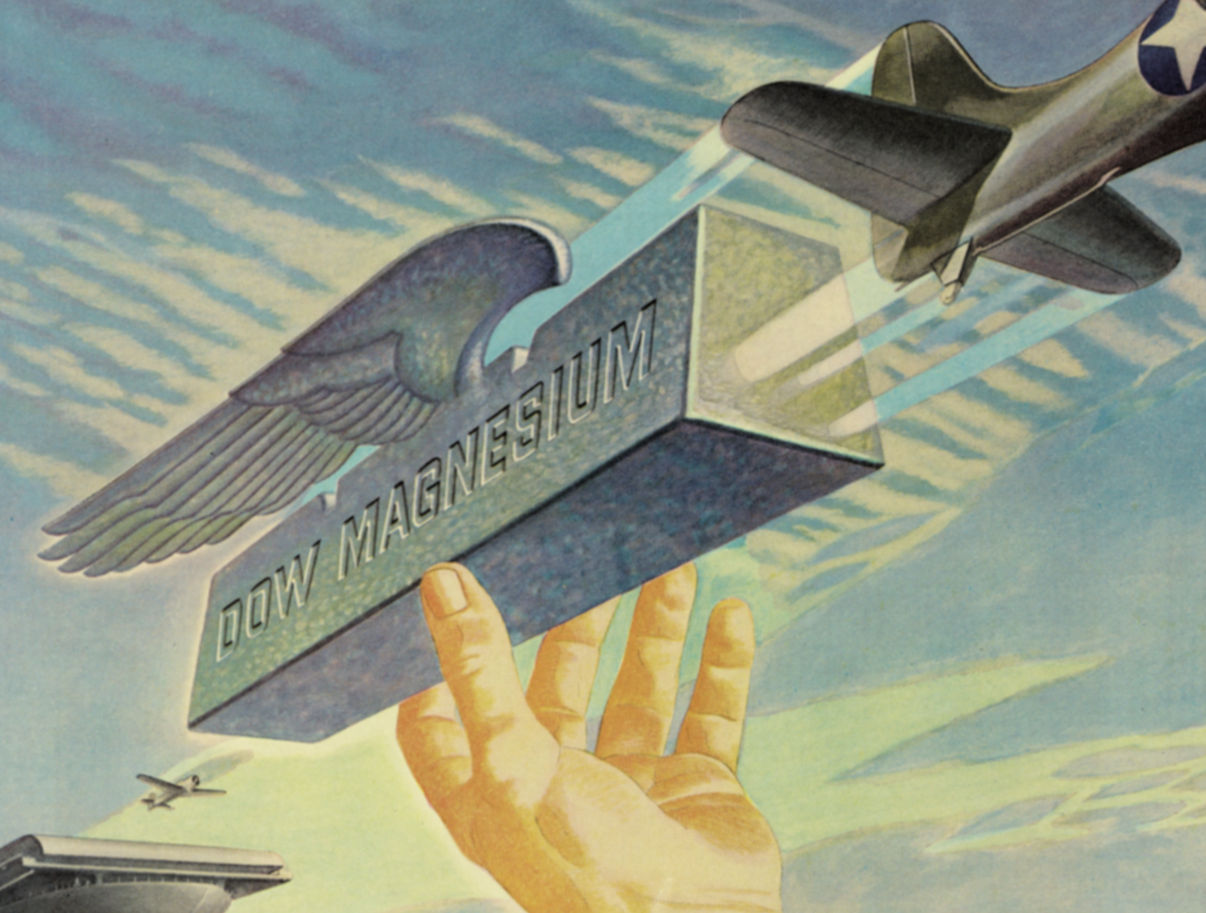
Photograph of a Dow poster from the 1940s illustrating the importance of magnesium to the war effort.
American Chemical Society | Industry | Industry Matters Newsletter | The Magnesium Shortage Is No Typical Supply Chain Issue
The Magnesium Shortage Is No Typical Supply Chain Issue
Industry Matters Newsletter 3 March 2022
Fritos and magnesium are an unlikely pair, but in today’s crazy world they share one thing in common: both are in short supply. I can’t find Fritos scoops anywhere in Midland, Michigan. Five stores all with bare Frito shelves. I don’t know the genesis of the great Frito shortage but suspect it is the “normal” supply chain issues wrought by the pandemic. The magnesium shortage is different. It is not a typical supply chain issue. It might truly be monumental.
Magnesium is a product of the chemical industry. It is always found combined with other elements in nature, never in its native form. Magnesium production requires chemistry.
Magnesium is not rare. It is the eighth most abundant element in the universe. It is the eighth most abundant element in the earth’s crust, at about 2%, and makes up over 13% of Earth, and over 2% of the crust. It is the second most abundant cation in seawater behind sodium. Mineral deposits and prevalence in the ocean make magnesium production possible in many places.

Photograph of a Dow poster from the 1940s illustrating the importance of
magnesium to the war effort.
Magnesium’s high strength-to-weight ratio makes it particularly attractive in applications where weight matters. When alloyed with other metals, it improves performance. Aluminum alloys are one of the largest uses. The chemical industry, in the form of Dow Chemical, figures large in the magnesium story. Dow, for over 80 years, was the world’s leading manufacturer. The magnesium production facilities at the Dow Freeport, Texas, site were memorable. The settling ponds used in magnesium production took on a turquoise hue, making them one of the few parts of a chemical plant where beautiful was a fitting adjective. The shutdown of production was noticeable, both in the market and visually at the site.
The Dow process was developed using mined brines but moved to using seawater as the magnesium source. The plant in Freeport was built for World War II manufacturing, to provide critical material for aircraft production. Magnesium hydroxide is precipitated by addition of lime to start the process. Reaction of magnesium hydroxide with hydrochloric acid gives magnesium chloride. Electrolysis of MgCl2 produces magnesium and chlorine. It is energy intensive, with much of the energy added as electricity. War production far exceeded peacetime need, leading to over-capacity after the war. The U.S. accounted for about half of the global supply in 1970, with Dow being the largest global producer. The U.S. share of production dropped to around 30% in the years prior to Dow exiting the business in 1998. Damage from hurricane Frances in 1998 caused Dow to fold the business. Production just ended. No buyer was found. The plants were simply bulldozed.
Fast forward to 2022. China now accounts for over 85% of global primary magnesium production. Chinese production uses the Pigeon Process, named for the inventor not the bird. Dolomite, a mixed calcium/magnesium carbonate mineral, is the magnesium source. Calcination releases carbon dioxide, producing magnesium oxide. MgO is reduced at high temperature with ferrosilicon, itself produced by the high temperature arc furnace reduction of silicon dioxide, quartz, in the presence of iron using coke as the reducing agent. Magnesium vapor exits the process and is condensed to collect the metal. Thermal energy and electricity in China are both supplied from coal. One ton of magnesium consumes 8-12 tons of coal during production. Coal is cheap, and low-cost magnesium from the Pigeon Process largely pushed other manufacturers out of the market. The electrochemical production lost out to the Pigeon Process, with its reliance on coal and higher greenhouse gas emissions.
This certainly sets up to be a typical supply chain story.
It isn’t. The current magnesium shortage
is due to greenhouse gas emissions.
China is sticking to its
commitment to reduce CO2 emissions, severely curtailing the
magnesium industry. There is ample dolomite, ample production capacity, and
ample coal.
The magnesium shortage marks the first time I know of where chemical production was shuttered purely to reduce greenhouse gas emissions. It is monumental. The ripple effects are being felt around the globe. Magnesium is a key, irreplaceable alloying material. Ninety-five percent of Europe’s magnesium comes from China. Aluminum, steel, and other metal industries are suffering supply shortages and price shocks.
The Fritos shortage is unlikely to have lasting impact. The magnesium shortage will not be as easily forgotten. Emissions curtailed chemical production for the first time, but likely not the last. Fortunately, we already know a better way. A cleaner path to produce magnesium is known, developed, and proven. It is the one the “dirtier” process replaced. Hopefully we will be compelled to change for the better.
Addendum: The magnesium market is the largest market impacted by Chinese emissions reductions. Yellow phosphorus also faces shortages,
produced in the same regions of China and curtailed to meet emissions targets just like magnesium. Both illustrate the risks of focused, offshore
production and of off-shoring emissions.